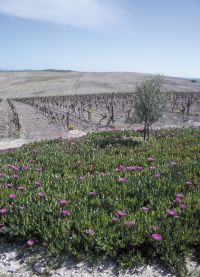 |
| The austere beauty of the Jerez region in springtime |
Sherry has been recognised and appreciated among experts for a very long time. It is considered one of the few top wines in the world that can be bought for far less than its true value. This is precisely what predestines it for a much broader range of uses than has been the case in Germany up to now. In addition, from the wide range of sherries, it is possible to find the ideal, reliable and mood-enhancing partner for almost every occasion and every dish.
Every connoisseur is aware that the country's formidable tapas and sherry form an inseparable unit, whereby mostly the dry finos are meant here. Hardly any other wine makes the palate and stomach as receptive to what is to come as a dry, light fino or manzanilla. There is nothing to stop you drinking such an elegant and fruity-salty wine right up to the main course of a meal; it complements vegetables, seafood and fish practically perfectly
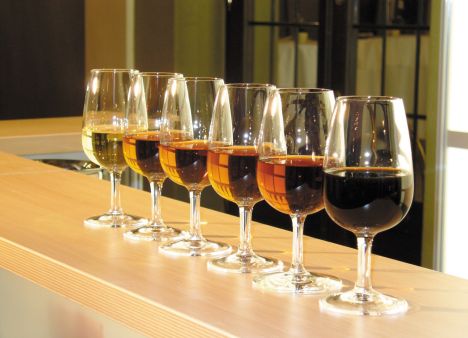 |
| The different wine colours indicate the versatility of this type of wine |
Less common, however, are combinations with Medium Olorosos or even Pedro Ximénez, even in the relevant tapas bars in Germany. Yet this would offer a wide field for culinary experiments and unexpected taste experiences. Spain's fine cuisine, which has rightly become so famous in recent years, is based to no small extent on daring but splendidly fitting combinations. Fortunately, you don't have to go that far to enjoy such delicacies. At the beginning of the year, the congenial team of Klaus Mayer (chef) and Jan Buhrmann (sommelier) from the "Ente" in Wiesbaden showed what is possible and feasible at the furious Copa Jerez cooking competition. Whereby possible, despite the exquisite ingredients, does not mean exaggerated and feasible does not mean artificial, on the contrary
So what food really goes with what?
Again, this is only a general guideline, you should find out for yourself the finest combination, many positive surprises are possible, but you can hardly make a mistake.
A broad field opens up, since there are so many different types of sherry and since every bodega has different wines. In general, Fino/Manzanilla can be enjoyed as an aperitif, with tapas, fish, simple grilled food and paella, Amontillado, Palo Cortado and Oloroso with beef, lamb and game, the sweet varieties with foie gras, sharp cheeses and desserts. A P.X. or Moscatel is usually a thing in itself, although borderline brilliant combinations are also possible here.
 |
| Sherry is currently experiencing a revival in Germany's top gastronomy |
The region
The fact that sherry comes from the south of Spain, from Jerez, may be taken for granted, but the exact production area is less well known even among otherwise sophisticated wine lovers. The zone is called the Sherry Triangle. Only wines produced there may call themselves sherry and bear the protected designation of origin Jerez-Xérès-Sherry. The main production area, which accounts for 8,300 ha of the region's total 10,500 ha, is bounded by the three towns of Jerez de la Frontera, El Puerto de Santa María and Sanlúcar de Barrameda.
The climate
The climatic conditions of this region shape the unmistakable character of the sherry: in particular, the proximity to the Atlantic influences its aroma. The breeze (poniente), which usually blows from the west, provides the vines with moisture from the sea and moderates the climatic extremes. This is particularly important in Sanlúcar de Barrameda and El Puerto de Santa María, where summer temperatures can be around 10° C lower than in Jerez de la Frontera. As a result, in high summer the vines are often covered in dew early in the morning, which provides them with additional liquid. Even in Jerez, 15 kilometres from the sea, the sea can still be felt: the humidity there can rise to over 90%.
The soil
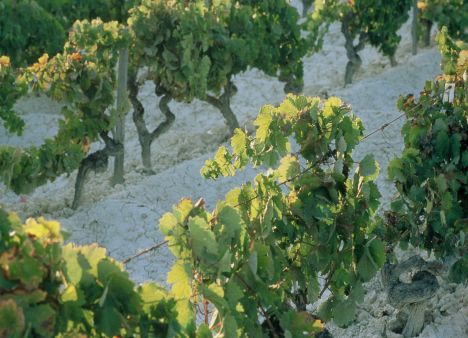 |
| Albariza% the highly calcareous soil of the Sherry region |
Nevertheless, the prolonged drought would normally be a problem for the vines. Not so in the Sherry Triangle: the secret lies in the bright white calcareous soils, the so-called "Albarizas" (from Latin Alba: white), which can store large amounts of water. The soil absorbs the water like a sponge and closes up on the surface during dry periods. When needed, the vines can absorb the stored water from the soil and thus supply themselves with sufficient liquid and nutrients even during dry periods.
The production
Sherry is subject to specific regulations which are monitored by a special control council, the "Consejo Regulador". Specifications on origin, grape selection and ripening procedures date back to the mid-19th century and are still valid.
95 % of sherry production consists of the Palomino variety. It is particularly suitable for the production of all sherry wines due to its neutral character and tendency towards oxidation. The Palomino grape prefers dry, sunny locations.
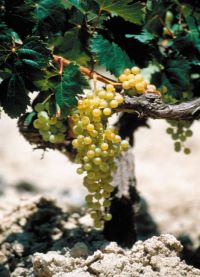 |
| Classic variety for Fino and Manzanilla: Palomino Fino |
The second authorised grape variety is Pedro Ximénez, or PX for short. It takes up about 3% of the vineyard area. The grapes, which are already naturally very high in sugar content, are dried in the sun for a few days before processing in order to increase the sugar content even more. The unusually dark Pedro Ximénez, which almost resembles a mocha, is also used to make special sherry varieties.
The third variety is Moscatel, but it is almost always marketed under its varietal name and is occasionally used to sweeten sherries.
For the D.O., a distinction is made between the following types: Vino Generoso (fortified wines, fully or partially aged under flor), Vino Generoso de Licor and Vino Dulce Natural.
The basic types: Fino and Oloroso
The grape harvest usually begins in early September and lasts about 20 days. To achieve the highest quality, the musts are fermented under strict temperature control.
During the "stormy" fermentation, more than 90% of the sugar content of the grapes is transformed into alcohol and carbon dioxide. In the calm final fermentation, the young wines already develop their special characteristics, which decide on their later development. The entire process runs until the beginning of December.
 |
| Flor% the classic yeast layer protects the wine from oxidation and gives it a unique aroma |
After that, the future sherry is generally a dry white wine on which a layer of yeast, the so-called flor, has already formed. Now a first classification is made, deciding whether the wine should be developed into a Fino or an Oloroso: Very light and light wines with a fresh aroma are classified as Finos. Wines with more body, a stronger colour and structure are classified as olorosos. From here on, the production paths of the basic sherry types separate. Both wines are now fortified with wine spirit to different alcohol levels, Finos to 15°, the Oloroso up to 17.5°.
Vinification: Fino and Amontillado
With Fino
the flor yeast layer, which looks like a wadded, white carpet, remains intact and seals the entire surface of the wine airtight. This layer prevents the wine from oxidising, extracts alcohol from it and adds nutrients. Finos are used to make the sherry types fino, manzanilla (a fino produced exclusively in Sanlúcar de Barrameda) and amontillado. Only when the alcohol content is between 14.8 and 15.5 percent by volume does the yeast layer remain. The yeast itself feeds on alcohol, sugar and oxygen. Therefore, the barrels for the maturation of these sherry types are only filled to a maximum of 4/5. The temperature must be constant at 15 - 20° C. The flor yeast thrives best in already used American oak sherry casks.
Maturation time: at least 3 years under flor, never oxidative.
With the Amontillado
a second process, the oxidative maturation, takes place. After maturing for at least 3 years under flor, the yeast layer of the sherry is dissolved by increasing the total alcohol content to over 17% using wine distillate. After the death of the flor, the wine is exposed to direct oxidation. In contact with the air, the sherry develops a whole new set of characteristics: The colour changes from the original light yellow to an amber hue, vanilla and tobacco aromas emerge and the wine becomes even more elegant and softer on the palate overall.
Ageing time: At least 3 years under flor, then oxidative ageing (rarely less than 5 years)
Palo Cortado
Rather rare and, according to general opinion, quite a desirable by-product. It is originally an Amontillado, but is matured for a shorter time under flor and longer oxidatively. It is said to combine the aroma of an Amontillado with the palate impression of an Oloroso.
Oloroso
In the case of olorosos, the yeast layer disintegrates due to the greater increase in alcohol content immediately after the addition of the wine spirit in December of the vintage year. As a result, the surface comes into continuous contact with oxygen and the wine oxidises from the start, giving it an amber to mahogany colour.
Maturation time: At least 3 years, oxidative only
In general, it can be said that high-quality sherries are always matured in the barrel for considerably longer than is prescribed.
The Solera System
Both basic types mature in the so-called solera system. The wine is filled into American oak barrels (botas), which are arranged in pyramid-shaped rows (escalas). The system consists of at least three rows. The lowest row of barrels, which is at the bottom, is called solera (from Spanish suelo = bottom) and gives the entire system its name. These barrels contain the oldest sherry. The rows of casks above are called criaderas. They contain the younger wines in ascending order. The company only bottles sherry from the bottom barrels for sale. If a certain amount is removed from the solera (the maximum permitted according to D.O. regulations is 40 %), exactly the same amount must be replaced by the sherry wine from the criadera above. This process continues all the way to the top row of casks. At the top, the barrel is filled with fresh vintage wine that has already matured for a year in the barrel and now matures for at least three years in the solera system to become the noble sherry. The older, more homogeneous and more complex the product is to become, the more "escalas", i.e. stages in the form of decanting, the wine goes through.
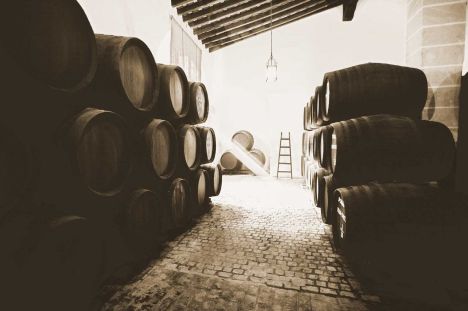 |
| The wines mature in the classic solera |
This traditional method has two major advantages: consistent quality and, in the case of finos and manzanillas, keeping the prescribed flor yeast alive.
The wines must mature in the solera system for at least three years before they are allowed to be sold. The top qualities usually have a maturation period of 5 - 8 years (for manzanilla and fino), other sherry types even 20 - 30 years (VOS/VORS) and more. Since this is a dynamic ageing process, the age always refers to the average age of the sherry.
Dry or sweet
With all basic sherry types, sweetening takes place only after complete maturation, as required. A distinction is mmade wine law):
|
|
Vino Generoso
Alcohol 15% - 22%, residual sugar BELOW 5g/L. This applies to Fino, Amontillado, Palo Cortado (a special form) and Oloroso.
Vino Generoso de Licor
depending on the type, at least 15% - 15.5% Alc
Dry (also Pale, Pale Dry) : light, under 45g RZ, usually sweetened with rectified grape concentrate, the most popular type in Germany.
Medium: brownish, under 114g RZ, base Amontillado or Oloroso, sweetened by RCGM or P.X
Pale Cream: light, under 115g RZ, base Fino/Manzanilla, sweetening by Moscatel or RCGM.
Cream: brownish, 114 - 140g RZ, mostly Oloroso with P.X.
Vino Dulce Natural
Varietal Pedro Ximenez or Moscatel: brownish to almost black, sugar from the grape (can also be dried), residual sweetness by stopping fermentation using wine spirit, RZ usually 170 - 400g/L.
How long can it be stored open/closed?
Fino/Manzanilla: approx. 1 week / approx. 18 months
Amontillado: 2-3 weeks / up to approx. 3 years
Oloroso: 1-2 months / 5-15 years
P.X.: 2-3 months / 15 - ? years
Of course, these are only approximate guidelines, it depends on the individual wine, in case of doubt it is always better to keep it shorter than longer. Sherry should be stored standing up, in a cool and dark place. Always keep opened bottles cool and sealed.